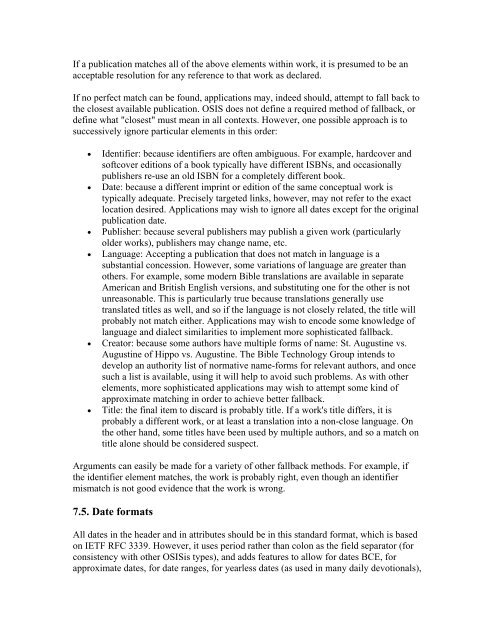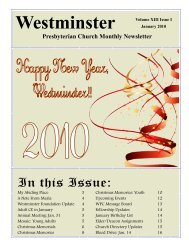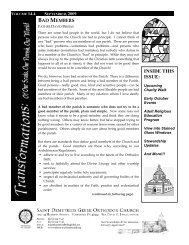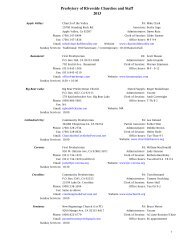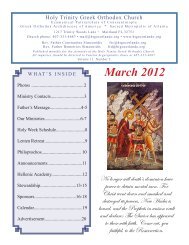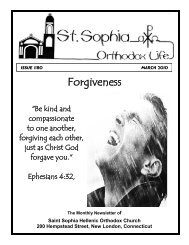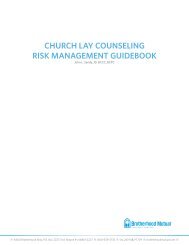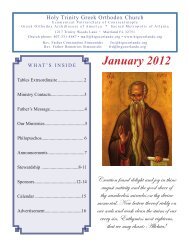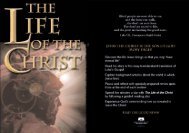OSIS? 2.0.1 User's Manual - Web services are running on AMBIB
OSIS? 2.0.1 User's Manual - Web services are running on AMBIB
OSIS? 2.0.1 User's Manual - Web services are running on AMBIB
Create successful ePaper yourself
Turn your PDF publications into a flip-book with our unique Google optimized e-Paper software.
If a publicati<strong>on</strong> matches all of the above elements within work, it is presumed to be an<br />
acceptable resoluti<strong>on</strong> for any reference to that work as decl<str<strong>on</strong>g>are</str<strong>on</strong>g>d.<br />
If no perfect match can be found, applicati<strong>on</strong>s may, indeed should, attempt to fall back to<br />
the closest available publicati<strong>on</strong>. <str<strong>on</strong>g>OSIS</str<strong>on</strong>g> does not define a required method of fallback, or<br />
define what "closest" must mean in all c<strong>on</strong>texts. However, <strong>on</strong>e possible approach is to<br />
successively ignore particular elements in this order:<br />
• Identifier: because identifiers <str<strong>on</strong>g>are</str<strong>on</strong>g> often ambiguous. For example, hardcover and<br />
softcover editi<strong>on</strong>s of a book typically have different ISBNs, and occasi<strong>on</strong>ally<br />
publishers re-use an old ISBN for a completely different book.<br />
• Date: because a different imprint or editi<strong>on</strong> of the same c<strong>on</strong>ceptual work is<br />
typically adequate. Precisely targeted links, however, may not refer to the exact<br />
locati<strong>on</strong> desired. Applicati<strong>on</strong>s may wish to ignore all dates except for the original<br />
publicati<strong>on</strong> date.<br />
• Publisher: because several publishers may publish a given work (particularly<br />
older works), publishers may change name, etc.<br />
• Language: Accepting a publicati<strong>on</strong> that does not match in language is a<br />
substantial c<strong>on</strong>cessi<strong>on</strong>. However, some variati<strong>on</strong>s of language <str<strong>on</strong>g>are</str<strong>on</strong>g> greater than<br />
others. For example, some modern Bible translati<strong>on</strong>s <str<strong>on</strong>g>are</str<strong>on</strong>g> available in separate<br />
American and British English versi<strong>on</strong>s, and substituting <strong>on</strong>e for the other is not<br />
unreas<strong>on</strong>able. This is particularly true because translati<strong>on</strong>s generally use<br />
translated titles as well, and so if the language is not closely related, the title will<br />
probably not match either. Applicati<strong>on</strong>s may wish to encode some knowledge of<br />
language and dialect similarities to implement more sophisticated fallback.<br />
• Creator: because some authors have multiple forms of name: St. Augustine vs.<br />
Augustine of Hippo vs. Augustine. The Bible Technology Group intends to<br />
develop an authority list of normative name-forms for relevant authors, and <strong>on</strong>ce<br />
such a list is available, using it will help to avoid such problems. As with other<br />
elements, more sophisticated applicati<strong>on</strong>s may wish to attempt some kind of<br />
approximate matching in order to achieve better fallback.<br />
• Title: the final item to discard is probably title. If a work's title differs, it is<br />
probably a different work, or at least a translati<strong>on</strong> into a n<strong>on</strong>-close language. On<br />
the other hand, some titles have been used by multiple authors, and so a match <strong>on</strong><br />
title al<strong>on</strong>e should be c<strong>on</strong>sidered suspect.<br />
Arguments can easily be made for a variety of other fallback methods. For example, if<br />
the identifier element matches, the work is probably right, even though an identifier<br />
mismatch is not good evidence that the work is wr<strong>on</strong>g.<br />
7.5. Date formats<br />
All dates in the header and in attributes should be in this standard format, which is based<br />
<strong>on</strong> IETF RFC 3339. However, it uses period rather than col<strong>on</strong> as the field separator (for<br />
c<strong>on</strong>sistency with other <str<strong>on</strong>g>OSIS</str<strong>on</strong>g>is types), and adds features to allow for dates BCE, for<br />
approximate dates, for date ranges, for yearless dates (as used in many daily devoti<strong>on</strong>als),


